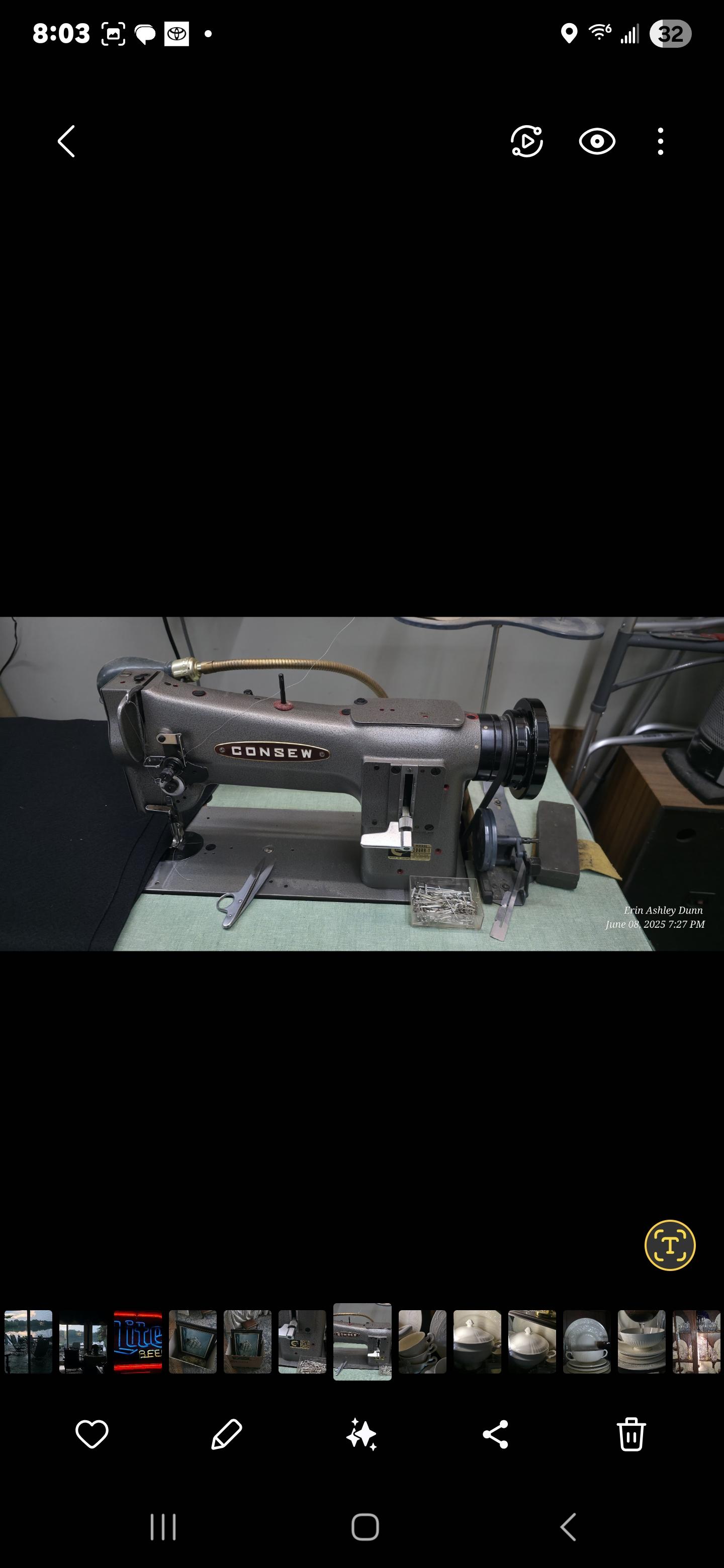All Activity
- Past hour
-

Randall leather sewing machine needs a shuttle
Wizcrafts replied to Vicki Vallencourt's topic in Leather Sewing Machines
Having owned and sewn on ULS machines, I can confirm that they are unlike modern single needle machines. I've owned several heavy duty lockstitch machines, but none can come close to the tightness of a properly adjusted Union Lockstitch machine. Admittedly, they take some time to learn how to operate and adjust them. But, it is worth the effort. I even taught myself how to sew thinner leather projects on mine. I was able to sew single leather 10-12 ounce bridle leather belts on my ULS machines. In some cases, that included sewing fishtail stitching patterns; aka: gunfighter stitching. I still use the knowledge gained on old ULS machines when sewing fishtail patterns on belts using my current big Cowboy cb4500. For anybody reading this topic and having a ULS or Randall lockstitch machine, I will share a tip I learned from experimentation to avoid ratting a previous stitch when sewing over it in a design, or to end a row by sewing over the starting stitches. As you approach a previous stitch, if you carefully rotate the work, or reposition the angle of the barbed needle, you can sew right next to an existing stitch without ratting it with a forward facing barb in the needle. I taught myself to just angle the stitch line to one side as the needle came up and the looper threaded it. As the barb comes down, I made sure the previous stitch was at an angle to the barb. If one masters this, you can sew inline over the starting threads without ratting them on the way down. Feel free to test this free tip! It was also important to choose the smallest needle that still held the top thread in place without dividing the thread strands. A filled needle is less likely to catch a previous stitch! Last time I checked, Campbell-Randall stocked needles and awls in a wide range of sizes. I always used an awl that was one number larger than the needle. If the finished project holes look too big, tap the surface with a steel harness makers' hammer. -
Kyra started following Skiver Help
-
My skiver spins when nothing on it but doesn't with the leather. I tried sharpening but it even stops spinning when the grinder hits it. So frustrating. VOD_20250701_204608.mp4
-
AlZilla started following 22W156 Manual?
-
I'm rehabbing a 22W156. I could use a manual, if someone has one. Don't need a parts list, I have several of them.
- Today
-
Scoutmom started following Pricking tool help!!
- Yesterday
-
spring flowers and good food
Sheilajeanne replied to chuck123wapati's topic in All About Us and Off Topic
Thank you, Johanna, and thanks to the mods for all the good work they do! We're lucky to have you! -
Johanna started following spring flowers and good food
-
spring flowers and good food
Johanna replied to chuck123wapati's topic in All About Us and Off Topic
I did one of those admin "Log everyone out at once" moves this morning, so that was probably me, but I had to get it to stop. Northmount, Alzilla & Wiz do a great job zapping spammers that get past me, but this morning was an attack. We have things under control again. I am fortunate to have such good help. ~J -
esch17 joined the community
-
dragonchino started following Consew 206RB-1 for sale
-
That machine sounds like the bobbin drops in vertically and a securing latch snaps down on top of the bobbin. If that bobbin thread slides out of the edge of the bobbin, it wil either wind around under over over the bobbin and wrap around the post or the snap down retainer. Maybe this bobbin thread is wound too loosle and is unwinding outside the edges of that particular bobbin. Try winding another bobbin and see if it has closer toerances inside the basket. Also, feed the bobbin thread against the rotation of the shuttle.
-
IMK joined the community
-
MarshalWill started following Stan Lee Portrait
-
Very well done. Looks realistic, which takes a good eye and touch with the tools. If you want to subdue the background stamping, could you go over it lightly with a modeling spoon?
-
juliasimpson joined the community
-
friquant started following bobbin thread binding
-
Sounds frustrating. Here are some things to try: Does the machine turn over freely when bobbin and bobbin case cap are removed? (Can turn handwheel a couple revolutions to check no binding) With bobbin case cap in your hand, and the bobbin loaded into it, does pulling on the thread show smooth, even tension? With bobbin case and bobbin installed in machine, but no fabric under presser foot, does pulling on the bobbin thread show smooth, even tension?
-
I have a cobra 26 that the bobbin thread is not feeding out correctly. The bobbin is installed correctly, the bobbin basket is moving freely but when I put the tab down over the top of the bobbin it starts to bind up. Been using it for a year and never happened before.
-

Randall leather sewing machine needs a shuttle
mbnaegle replied to Vicki Vallencourt's topic in Leather Sewing Machines
@bruce johnson @kgg @Vicki Vallencourt Thanks for the kind words guys. I enjoy curating the history of our companies and have bene planning on starting a thread or two about it (when I find that "round-to-it"). @Wizcrafts Thanks for the testimonial! I guess my "neutral" side is more that I'm a believer in investing in quality "classic" tools and machinery, and I think needle and awl lockstitch machines are the best at sewing medium to heavy weight leathers (compared to other modern rotary hook closed eye needle machines on the market), but some might take that as I'm just trying to sell machines since ours (the Campbells, Randalls, and Union Locks) are the only manufacturer supported needle and awl stitchers left. New machines are not cheap though (about $8000 these days), and we typically have a long waiting list for them, so whatever you can use to get your product made is a win. I'm happy to see any used machines out there get put to work as it keeps the machines reputation rolling. I do plan on doing some more technical threads and videos, especially on the Campbells and Unions. I tell people often that there's a reason these machines were designed with a tool tray on the front. You've got to be comfortable and familiar enough fine tuning them every now and then same as any other sewing machine, but all the guys I know that get over that hurtle love the machines in the end. For example with the Union Lock, which has a very polarized reputation for needing periodic adjustment, it has ABUNDANT points of adjustment that can slip out of time, but once you understand how to put it all in place and keep it there, that machine will run forever because as things wear you can keep tightening them up. Campbells and Randalls can and do get run into the ground, needing extensive repairs and parts replaced eventually, but we haven't had one yet that we couldn't save. Those cases are rare though. We have one Campbell on display in our lobby that was on lease for 70 years needing no major repairs or rebuilds and it still sews great. They're not difficult to operate either. True, I grew up around them, but my first time running one was when I was around 10 or so at a trade show with 5-10 minutes of instruction from my dad, and It was a blast. Campbell's, Randall's and Landis #3's are what I consider 2nd generation needle and awl machines. The first generation machines being Landis #1's and similar early low speed machines (better than hand stitching, but long since outdated), and 3rd generation machines being high speed Union Locks, Landis 16's and Cyclones. In my opinion, that 2nd Generation really got things right. They relied on cams and levers and oscillating shuttles (mostly) in their designs and are mechanically very durable and well built. They operate comfortably at a decent pace that operators can keep up with without having the work get away from you. The 3rd gen machines could go faster, but it's like driving a car where just because the car can do 200mph, doesn't always mean the driver or the road are up to it. They also often have more complicated parts making them more expensive to produce, which is a big part of why our Cyclone had so few machines made. The needle and awl design is what really makes these machines unique though. That action of punching and threading the hole, going back and forth from either side, with the needle or awl feeding the work, mimics hand stitching and produces very little puckering on the back of the work when compared to a closed eye needle machine. That process also enables some unique abilities like corner stitching. Like Wizcrafts noted too, the Campbell/Randall machine has an automatically adjusting looper that will keep a uniform stitch when sewing up and down inclines, while other machine need tension adjustments when thickness's change. So yes, I'm biased, but I'm also the kind of salesman that I don't want to "convince" anyone of anything. Good products should sell themselves and it's the companies job to support it best as possible. The cost of building these machines is one thing we couldn't fudge if we wanted though, and we learned a long time ago that we'll never be able to compete with imported machines in that regard. Fortunately, there's been enough like minded clients out there who want to invest in a premium machine that will outlive them, so we keep kicking the 140 year old tech around . -
Wizcrafts started following Randall leather sewing machine needs a shuttle
-

Randall leather sewing machine needs a shuttle
Wizcrafts replied to Vicki Vallencourt's topic in Leather Sewing Machines
During the mid-1980s, I was trained to sew harness straps and reins on a Randall Lockstitch machine from the early 20th Century. The straps and reins tapered from about 1/4 or 3/8 inch at the folded ends to a solid 3/4 inch along the length. That machine laid down the most perfect stitches using yellow 4 cord Barbour's Irish linen thread. It chugged along at 300 rpm, which translated to a about 3 stitches per second. The thread ran through a waxpot filled with Super Ceroxylon clear thread lube/wax, which is still available from Campbell-Randall Co. When straps were much longer, or time was of essence, I switched to running a Union Lockstitch Machine, built around 1940. It ran at 15 stitches per second when I floored it! Campbell-Randall is still the rebuilder and seller of the ULS machines. They stock parts, needles and awls for it, as well as the Campbell and Randall Lockstitch macines. I've owned two Union Lockstitch machines, so far. I have a friend in Roseville Michigan who owns and uses one Union Lockstitch and three Campbell-Randall Lockstitch machines. I can honestly say that unless one never oils or maintains them, these machines will keep working as designed for over a century. This information was totally unsolicited. I am simply sharing my personal experience running their machinery. It was and continues to be targeted at the harness making and repairing industries. -
.thumb.jpg.6e903dd66163ad5672f00f144058c571.jpg)
spring flowers and good food
Northmount replied to chuck123wapati's topic in All About Us and Off Topic
Remember to use your email address that you use with LW instead of the user/screen name. -
All's Quiet On The Western Front - now I keep two windows open; one for All Activity and one for Unread Content The Unread Content page wanted me to log in again, Nae Prob. But when I did I got a screen with a message saying 'Ooops! Try Again' BUT the All Activity page just worked as normal All's Well that Ends Well
-
AlZilla started following spring flowers and good food
-

spring flowers and good food
AlZilla replied to chuck123wapati's topic in All About Us and Off Topic
BossLady stopped the flood and I think the bulk of the spam messages are gone. Many hundreds of them! Feel free to report anything you see so we can smite them down. -
Some times, the items made in China/Vietnam/Taiwan et cetera are for the named company but the second- or third - quality items, the ones that don't get through the quality inspection, are sold off cheap to the seller on ebay and TEMU
-
Its not completely fixed
-
BlackDragon changed their profile photo
-
Earlier today (~6:30 am Ontario time) the forum was trashed with spam but seems to be back up and running properly. Thanks to whoever fixed the problem. kgg
-
Randall leather sewing machine needs a shuttle
kgg replied to Vicki Vallencourt's topic in Leather Sewing Machines
@mbnaegle I can say I really enjoyed reading the history around these old machines. kgg -
spring flowers and good food
Sheilajeanne replied to chuck123wapati's topic in All About Us and Off Topic
Wait - what did I miss here? :O -
Johanna started following Unread Notifications
-
looking into this
-
Try weaver supply. They have the rounded shape you are looking for.
-
Galinaprix joined the community
-
Ask for airlines changed their profile photo
-
spring flowers and good food
Handstitched replied to chuck123wapati's topic in All About Us and Off Topic
We have 240v in Oz and 415v 3 phase. @Northmount I have reported it but some nut job has totally trashed the site -
allenmyer changed their profile photo
-
Me too, Pastor Bob! My favourite was where Thor gives him some Asgardian liquor and he gets totally drunk! "EXCELSIOR!!" My one criticism is the blank glasses just weird me out. I know it won't be easy to do, but I think you need to give him some eyes behind those glasses. Excellent job - I can't imagine doing portraits in leather!








